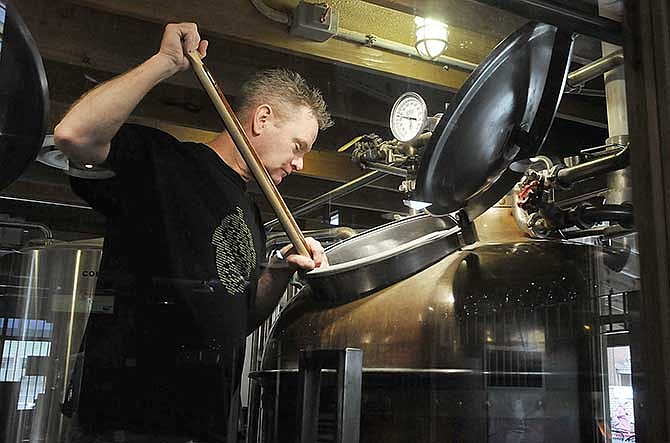Wearing blue jeans, a plain red t-shirt and a hat with "Nemo Grain Ethanol: Macon, Mo." across the front, Orion Beckmeyer walked down rows of vines in his vineyard near Hartsburg, examining young grape buds.
Small green and orange buds were beginning to emerge from the trimmed, woody grapevines. The vines run from east to west along sloping former pastureland, and Beckmeyer ducked under vines as he roamed from row to row, critiquing the quality of the pruning job and explaining the busy grow and harvest season ahead. Over the next few months, the buds will grow into tendrils 10-feet long and drape down from the vines in a curtain of green.
"I just wait and see what comes out," he said. "Like what are you going to do? We prune them up and hope for the best."
This year's winter and spring have been colder than the past few seasons, so the grapes are slow to wake up from their annual winter sleep. With Missouri's up and down spring temperatures, grape growers are at constant risk of being devastated by late spring frosts that kill off bunches of grapes in their most early development.
In February and March, Orion and a few temp workers pruned each vine in his eight-acre vineyard, cutting back the dead branches. Through the spring months and into the summer, the vines are sprayed with pesticides every two weeks to keep diseases at bay. In April, the buds begin to emerge and grow throughout the summer, reaching the ground in June. Bunches of grapes slowly spring from the vines and mature in the summer heat until they are ready to pick in the early fall.
Beckmeyer, 74, has lived near Hartsburg for 50 years, growing corn on the family farm before planting grapes in 1999 as a "retirement." He started with the four-acre plot and then added another four acres.
Beckmeyer was examining a four-acre plot on a warm late-April morning. This patch was his original field planted 14 years ago and includes one acre of Traminette and Norton, two acres of Chambourcin and one acre of Chardonelle.
"I've got a full-time job, and I am quote "retired,'" Beckmeyer said with a laugh. "If you've got grapes, you can always go to the vineyard and find something to do."
Beckmeyer is one of dozens of small vineyard owners across the state. Some have converted old soybean or corn farms into rows of grapevines, while others have sought out the state's prime vineyard real estate on the sloping hills alongside the Missouri River. All told more than 390 vineyards dot the state, many supplying the state's 118 wineries - an industry with a more than $1.5 billion economic impact on the state each year.
Many of these wineries and vineyards, including Beckmeyer's, have used a tax credit that took effect in 1999 and allows winemakers and grape growers to receive a 25 percent credit for the purchase of "all new equipment and materials used directly in the growing of grapes or the production of wine in the state." Individuals could use the credit in up to five tax years.
Since 1999, the Department of Economic Development has approved more than $6 million worth of the credits. More than 160 individuals and companies took advantage of the credit since it was established.
But more than $4.3 million of the $6 million in credits went to the 10 largest users of the program, including more than $2 million in credits to Stone Hill Wine Co. in Hermann. The next biggest users were Mpw Inc. and St. James Winery, with just more than $530,000 in credits each.
The top users of the tax credit are:
- Stone Hill Wine Co. $2,005,629 (Hermann)
- Mpw Inc. $565,545 (Branson)
- St. James Winery $539,512 (St. James)
- Les Bourgeois $269,678 (Rocheport)
- Augusta Wine Company $230,165 (Augusta)
- Meramec Vineyards LLC $170,250 (St. James)
- Hermannhof Winery $162,715 (Hermann)
- Jacquelyn Johnson $140,195 (Ste. Gen.)
- Crown Valley Winery $127,836 (Ste. Gen.)
- Chandler Hill $115,364 (Augusta)
Usage of the credit has tapered off in recent years, with the total number of credits approved for the past three years less than the number approved in any single year between 2007 and 2010. Since individuals are limited to five years' worth of the credits, many wineries and vineyards are no longer eligible for the program.
The economics of winemaking include high fixed costs to get going, requires lots of working capital, is highly labor intensive and can fluctuate drastically based on year-to-year weather changes. Just a single night in April below freezing can wipe out an entire year's crop. The credit was designed to address these challenges and jumpstart the state's industry, which has grown drastically in the past 20 years.
Taking advantage of the credit, the Beckmeyers were able to purchase the trellises, posts, wires and vines they used to get their backyard vineyard up and growing. "It takes quite a bit of investment to put an acre in," Beckmeyer said. He said if it hadn't been for the credit program, he would have bought used rather than new equipment.
"We're paid out, but we are established growers," he said. "I guess that was the intent of the program.... It's not a get rich fast scheme."
As the credit's usage begins to wane, lawmakers are looking at potential tweaks to the program, including allowing credits for the purchase of used equipment and even letting brewers and distillers have a slice of the pie.
Rep. Bart Korman, R-High Hill, introduced a bill this session that would expand the credit to include liquor distillers and microbrewers, new and used equipment and would cap the total amount of the credits per year at $4 million and would cap individual credits at $100,000. The bill was well received by the House economic development committee and was endorsed by the panel but has yet to receive any attention by the whole chamber or even make it onto a floor calendar.
Rep. Anne Zerr, R-St Charles, filed legislation to include used equipment in the credit and cap the total amount of credits allowable each year at $200,000. Her bill did not include breweries in the mix.
By only crediting new equipment, the current program has left many small vineyards and wineries without a chance to take advantage of the credit. If the credit were extended to include used equipment, dozens of smaller vineyards and wineries would likely find themselves in a position to receive savings the next time they were on the market for vines, posts or any type of equipment.
The House economic development committee was generally receptive to the idea of including brewers and distillers to the credit but wanted there to be some protections for wineries and vineyards so the others didn't eat up all of the credit. But attempts to change existing tax credits or create new ones have been bogged down by strident opposition among some senators to big tax credits dedicated to low-income housing and historic preservation.
Prison Brews
Tweaking the credit to include used equipment or establishing new caps are one thing, but including breweries and distillers has the potential to be a game changer. Thousands of people attended the Missouri Beer Festival in Columbia this spring, and new breweries are popping up across the state, from Rolla and Jefferson City to Columbia, St. Louis and Kansas City.
In Jefferson City, Prison Brews owner Debbie Brown said any opportunity to save money on equipment would be welcomed relief in another capital-intensive business. Her brewery bought its beer making equipment used from a brewery in Washington, D.C., for around $83,000.
In a room behind the restaurant seating and long bar at Prison Brews sits a brew kettle - copper on the outside and stainless steel on the outside. Beside that is another room with a half-dozen stainless steel tanks used for fermenting the beers. In this small brewery, brew master Rod Dothage creates seven beers that the brewery has on tap.
"I basically just taught myself through a lot of trial and error and drinking," Rod said.
He had a home brewing setup while working as a landscaper, when he met Brown and gave her a taste of his brown ale, which is now a staple at Prison Brews along with six others. Most of the recipes he has developed while working among the brew kettle, mash ton, fermentation tanks and eight barrel kegs.
"He brought a keg of brown in the back cooler, and I said, "Oh yeah, this is the one I want,'" Brown said.
After he produces the beer, it is piped into a cold storage room with seven serving tanks that pump the different beers directly to the taps and into the glasses of eager patrons - basically a huge kegerator. The tanks are stainless steel and hold about 250 gallons of beer.
While there is not a lot of space to expand the brewing space at the brewery, Dothage said he sometimes gets backed up and could use additional capacity to meet the drinkers' demands.
"Some of the styles take five to six weeks to make, and they drink a batch of it in three to four," he said.
As the only brewery in town, Prison Brews has taken off and gained regular customers as well larger events and weekly live music. Brown said the Honey Wheat is popular with big crowds, but the regulars like the IPA.
"Business has been good," Brown said. "Every year has been better than the one before."
St. James Winery
While there are many small vineyards and wineries across the state, the big dogs dominate the market share and were the biggest beneficiaries of the wine and grape tax credit. Stone Hill Winery in Hermann has a labyrinth of cellars and warehouses on its grounds with dozens of stainless steel tanks squeezed into every corner. They couldn't identify exactly what pieces of equipment they used the credits for without paying their accountants to dig back through old books.
In St. James near Rolla, Peter Hofherr was born into a wine family. His parents started the winery in 1970, producing about 8,000 gallons. Now the large winery produces more than 200,000 gallons and distributes popular sweet wines throughout the state and region.
Three rows of eight 15,000 gallon stainless steel tanks, two giant presses, and a room of the four 25,000-gallon tanks welcome Hofherr as he walks from the store room at the front of the winery back to his office.
"The ability to buy used equipment helps them produce better quality," Hofherr said. "With used, you get quality without spending everything you have."
He has a business background and speaks in the clinical terms of an economist or risk manager.
Quality will increase profitability and increase access to outside markets, which will create a broader appeal for agri-tourism, creating demand for restaurants and hotels near the wineries and vineyards. He said the industry has grown a strong foundation and can now focus on increasing quality and broadening its appeal both within Missouri and across the nation.
Hofherr thinks the Legislature's interest in the wine industry over the past decades has helped push the industry in a positive direction, citing upward trend lines in the number of wineries and vineyards in the state, total revenues and out of state sales.
But there is still so much further to go. He said Missouri wine is 8 percent of the total wine drunk in the state, but that it could easily be closer to 12 percent and that the industry could grow another 50 percent as a whole if the right pieces are in the right places.
"The more wineries we have the better, because the wine culture increases," Peter said.
Another priority for the state's wine industry is building a $3 million teaching winery at the University of Missouri in Columbia. Ingolf Gruen, interim director of the Wine and Grape Institute at MU, said the institute in coordination with industry groups have secured half of the necessary funding and are waiting for the Legislature to appropriate the other half before moving forward with architectural and engineering plans and site selection.
Senate budget chairman Kurt Schaefer, R-Columbia, said he thinks the teaching winery would be a valuable asset for MU and the entire state, and he would like to see money appropriated for it in the next couple of years.
Jim Anderson, executive director of the Missouri Wine and Group Board, an appointed governmental board, said the teaching facility is necessary to teach the next generation of winemakers and keep them in the state.
"I would like to see this facility erected in the next five year," he said. "It's very important for us to see that to get to the next level ... A place where our young people can go off to study about research and learn about growing of grapes and winemaking, the whole process."
They used to pick the grapes by hand, before moving to machine picking three years ago. The Beckmeyers sell their grapes to Les Bourgeois Winery in Rocheport, but he keeps a small amount of the grapes for his own winemaking operation. "I didn't hardly drink anything until I started growing grapes."
Back near Hartsburg, Beckmeyer thought back to past harvests. When they pick the grapes in the fall, he said they start at 3 a.m. and can pick nearly five acres in a single morning. Before they started using the machine picker, they would pick more than 15 tons of grapes by hand with the help of dozens of family and friends.
"That's a lot of buckets," Beckmeyer said. "I don't think we got that done in one day... No."
While he wouldn't recommend it to everyone, Beckmeyer enjoys using his hands and getting outside - farming is in his blood.
"How many retirement hobbies are in the black? Most are in the red... part of that keeps me healthy, part of that wears out my joints."





